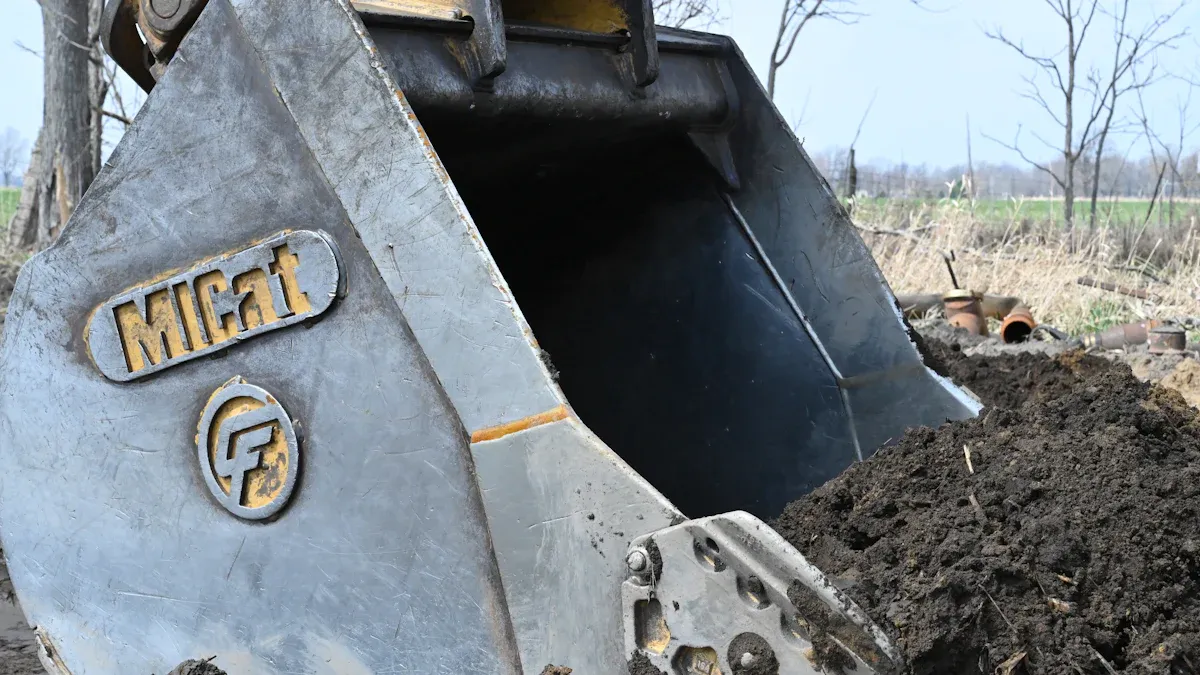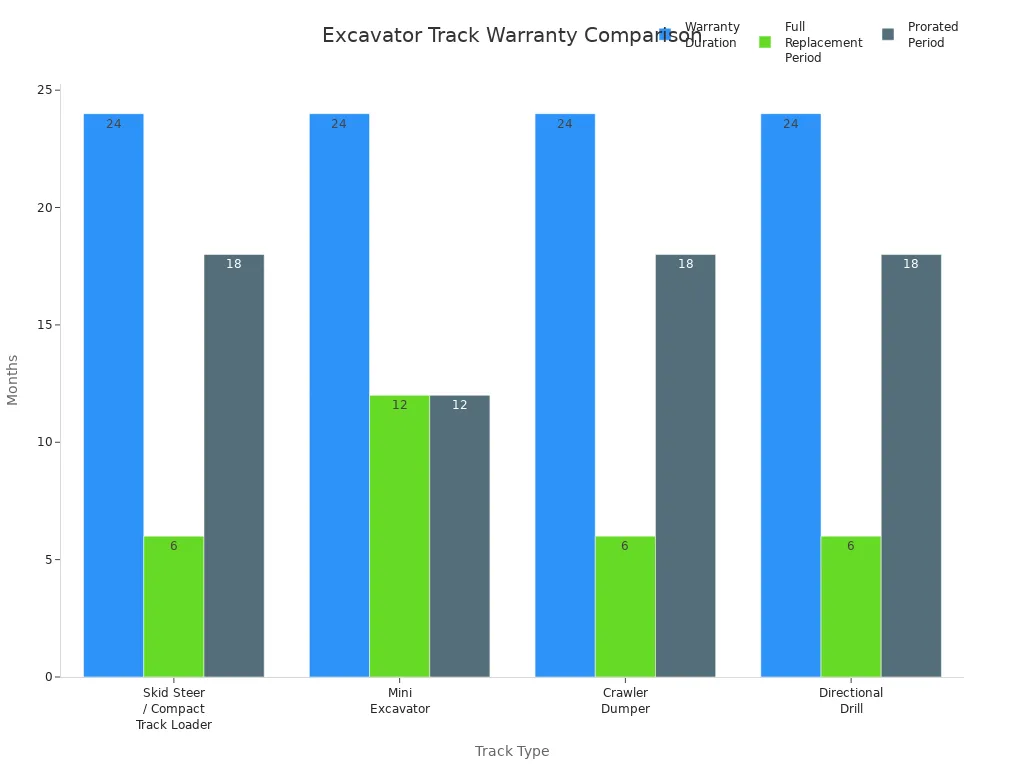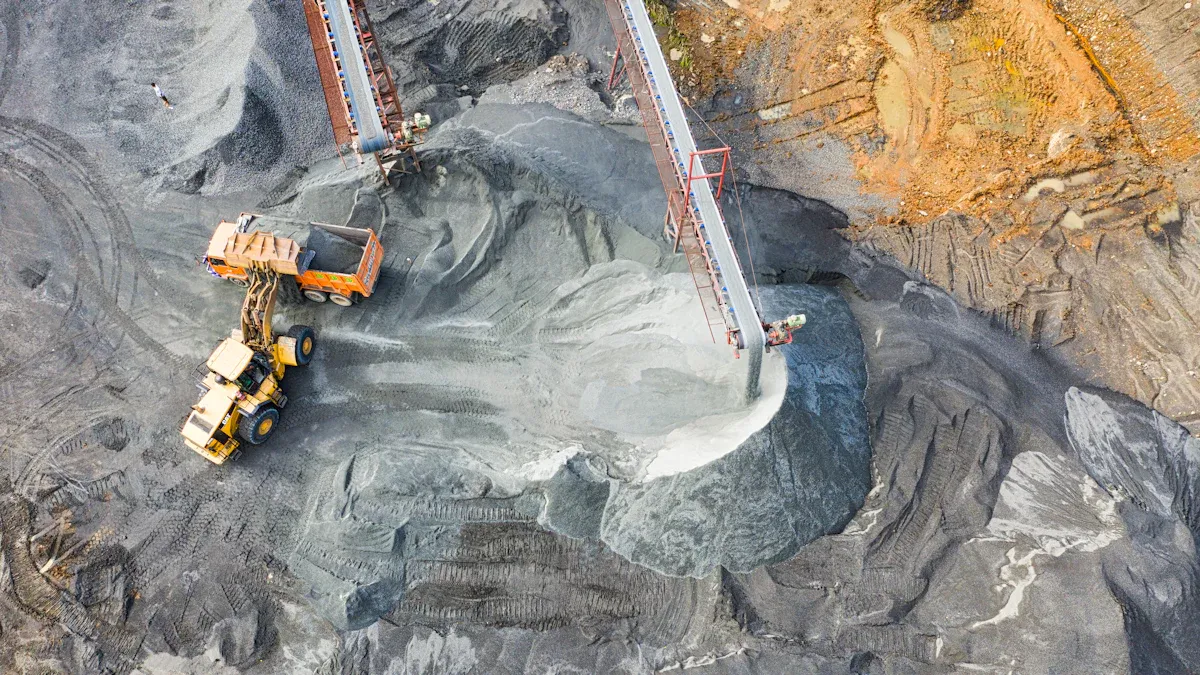
Choosing the correct excavator tracks boosts efficiency on every job site. Operators see better performance, less wear, and lower costs. The right tracks match the machine, job needs, and ground conditions. Reliable excavator tracks deliver smoother movement and help extend equipment life.
Key Takeaways
- Choose excavator tracks that fit your machine type, job needs, and ground conditions to boost performance and reduce wear.
- Rubber tracks protect surfaces and reduce noise, steel tracks offer durability for tough jobs, and hybrid tracks balance both features.
- Regular maintenance, proper installation, and daily inspections extend track life and save money by preventing breakdowns.
Key Factors in Selecting Excavator Tracks

Machine Type, Usage, and Track Compatibility
Selecting the right tracks starts with understanding the machine type and how it will be used. Each excavator has specific requirements for track size, width, and pitch. Using tracks that match the manufacturer’s specifications ensures the machine works safely and efficiently. Operators should always check the equipment manual or consult with a dealer before choosing new tracks.
Tip: Proper track compatibility prevents accidents and keeps the excavator stable, especially on slopes or uneven ground.
The table below highlights important factors to consider when matching tracks to your machine:
| Factor | Details & Considerations |
|---|---|
| Terrain Type | Steel tracks for tough terrain; rubber tracks for softer or mixed surfaces; hybrid tracks for mixed conditions. |
| Track Material Options | Steel: durable, handles extreme temps. Rubber: flexible, affordable, absorbs shock. Hybrid: combines both. |
| Track Patterns | C-pattern for clay/mud, straight bar for wet, zig-zag for mixed, turf for grass/asphalt. |
| Machine Size & Specs | Track size must fit machine; some tracks not available for all sizes. |
| Operator Comfort | Rubber and hybrid tracks reduce vibration and fatigue. |
| Maneuverability | Rubber tracks are lighter and faster; steel tracks offer more stability. |
| Budget | Steel costs more but lasts longer; rubber is cheaper but may need more repairs. |
| Environmental Impact | Rubber and hybrid tracks protect delicate surfaces. |
| Project Needs | Aggressive tracks for tough jobs; less aggressive for landscaping or sensitive areas. |
Excavator tracks made from high-quality rubber offer excellent wear resistance and elasticity. These tracks help isolate metal parts from the road, reducing wear and extending service life. Rubber tracks are also easy to install and protect the ground surface, making them ideal for many projects.
Ground Conditions and Terrain Impact
Ground conditions play a major role in track selection. Mud, gravel, asphalt, and rocky surfaces each require different track patterns and materials. For example, C-pattern tracks work well on clay, mud, and gravel, while straight bar tracks provide maximum traction in wet or muddy areas. Zig-zag patterns excel on mixed surfaces, and turf tracks protect grass and asphalt.
- Steel tracks handle rough, rocky terrain and heavy-duty jobs.
- Rubber tracks provide better grip and flexibility on uneven or soft ground.
- Hybrid tracks combine the best features of both, offering durability and comfort.
Note: Uneven or rough terrain increases track wear. Using track guards and inspecting undercarriage parts daily can extend track life by up to 1,500 hours.
Track material quality matters. High-grade rubber resists abrasion and heat, while reinforced steel cords add strength for tough environments. Choosing the right track for the ground conditions reduces wear, improves traction, and protects both the machine and the worksite.
Budget, Lifespan, and Cost-Effectiveness
Budget and lifespan are key factors when choosing excavator tracks. While steel tracks have a higher upfront cost, they last longer and handle harsh conditions. Rubber tracks are more affordable and easier to install, but may require more frequent replacement, especially on rough terrain.
The average lifespan for rubber tracks is about 1,000 to 2,500 hours, depending on maintenance and usage. Excavators themselves often last 7,000 to 10,000 hours before major repairs are needed. Regular cleaning, tension checks, and careful operation help maximize track life and reduce long-term costs.
Tip: Investing in high-quality rubber tracks and following maintenance guidelines saves money over time by reducing downtime and replacement needs.

Choosing the right excavator tracks means balancing initial costs with long-term performance and maintenance. High-quality rubber tracks, for example, offer excellent value by protecting both the machine and the ground, while also being easy to install and maintain.
Excavator Tracks Types and Their Applications

Rubber Excavator Tracks: Features and Best Uses
Rubber excavator tracks deliver outstanding performance in environments where surface protection and quiet operation matter most. These tracks use reinforced rubber with embedded steel cords, giving them both strength and flexibility. Operators choose rubber tracks for their smooth ride and ability to reduce ground disturbance. The elastic rubber spreads the machine’s weight, lowering ground pressure and preventing deep ruts. This makes them perfect for lawns, golf courses, and urban construction sites.
Key benefits of rubber excavator tracks include:
- Superior traction and stability on mud, sand, rocks, and uneven ground.
- Reduced machine noise, creating a quieter and more comfortable work environment.
- Excellent surface protection, preventing damage to concrete, asphalt, and finished landscaping.
- Improved operator comfort due to lower vibration and noise.
Common uses for rubber tracks:
- Landscaping and grounds maintenance
- Pool and spa installation
- Utility trenching and drainage ditches
- Residential construction and street cleaning
- Working on finished surfaces like sidewalks and curbs
Operators who need to protect delicate surfaces and minimize noise will find rubber excavator tracks the best choice for maximum efficiency.
Steel Excavator Tracks: Durability and Heavy-Duty Performance
Steel excavator tracks stand out for their unmatched durability and traction in the toughest conditions. These tracks use metal links that resist damage from sharp objects and rough terrain. Steel tracks last longer than rubber tracks in heavy-duty applications, making them the preferred option for demanding jobs.
Advantages of steel tracks:
- Superior durability in rocky, abrasive, and demolition environments
- Excellent traction and stability on steep, uneven, or muddy terrain
- Increased stability and lifting capacity for large machines
Steel tracks work best in:
- Heavy-duty construction sites and demolition projects
- Mining and forestry operations
- Rugged, rocky, or unstable terrains
Operators who face harsh ground conditions and need maximum stability rely on steel excavator tracks. These tracks handle the most challenging jobs, providing long-term value and reducing replacement costs.
Standard, Heavy Duty, and Heavy Duty XL Tracks Comparison
Choosing the right track grade ensures the excavator performs at its best. Manufacturers offer standard, heavy duty, and heavy duty XL tracks to match different project needs.
| Track Grade | Construction Features | Best For |
|---|---|---|
| Standard | Basic rubber or steel, lighter build | Light construction, landscaping, urban jobs |
| Heavy Duty | Thicker rubber/steel, reinforced cords | General construction, moderate rough terrain |
| Heavy Duty XL | Maximum thickness, extra reinforcement | Demolition, mining, extreme rocky terrain |
- Standard tracks suit smaller machines and lighter tasks where ground protection is key.
- Heavy duty tracks offer a balance of strength and flexibility for most construction projects.
- Heavy duty XL tracks provide the highest durability for the most demanding environments.
Selecting the right grade of excavator rubber tracks ensures the machine delivers top performance, reduces downtime, and extends equipment life.
Table: Main Types of Excavator Tracks and Their Applications
| Track Type | Characteristics | Primary Applications |
|---|---|---|
| Rubber Tracks | Reinforced rubber, smooth ride, low ground disturbance, quieter operation | Urban environments, landscaping, light construction, surface protection |
| Steel Tracks | Metal links, highly durable, excellent traction, heavier, higher replacement cost | Rugged, rocky, muddy, or abrasive terrains, heavy-duty construction |
| Hybrid Tracks | Rubber and steel combo, replaceable pads, mid-range cost | Mixed conditions, balance of durability and surface protection |
Operators who match the right track type and grade to their project requirements achieve maximum efficiency and cost savings.
Practical Tips for Choosing the Right Excavator TracksAssessing Project Needs and Track Size Selection
Choosing the right excavator tracks starts with a careful assessment of the project. Operators should follow these steps to ensure the best match:
- Visit the job site and measure excavation volume, handling needs, and cycle times.
- Compare equipment performance using data platforms to find the most efficient model.
- Monitor fuel use and test loads to understand fuel efficiency.
- Check operator comfort by reviewing cab layout and gathering feedback.
- Test equipment durability with material checks and vibration monitoring.
- Analyze the site for space limits, terrain, and environmental factors.
- Define tasks clearly, such as earthwork or fine construction, and assess risks.
- Review the budget, including purchase, maintenance, and energy costs.
- Arrange machine trials and seek expert advice for technical insights.
- Confirm quality with certifications and after-sales support.
Track size selection also plays a key role. Wider tracks improve stability and traction on soft or uneven ground. Narrower tracks help in tight spaces and make transport easier. The right track width ensures safe operation and boosts productivity on every job.
Maintenance, Installation, and Usage Precautions
Proper maintenance and installation keep excavator tracks performing at their best. Operators should always follow the manual and safety rules. When installing new rubber tracks, prepare the machine on a flat surface and engage the parking brake. Start installation at the sprocket, tighten the track gradually, and avoid over-tightening. Test the track by moving the machine forward and backward.
During use, avoid sharp turns and sudden stops. Drive in straight lines and alternate turning directions when needed. Prevent the tracks from rubbing against curbs or sharp objects. Regularly inspect the undercarriage and replace worn parts. These steps help extend track life and reduce downtime, ensuring every project runs smoothly.
Matching the right tracks to each project boosts productivity by up to 30% and cuts fuel costs. Operators see less equipment wear and longer service life when they choose tracks based on machine size, terrain, and job needs.
- Regular inspections and proper tension keep machines running longer.
- Training and clean worksites reduce breakdowns.
FAQ
What are the main benefits of using rubber excavator tracks?
Rubber tracks protect surfaces, reduce noise, and extend machine life. Operators enjoy easier installation and smoother operation. These tracks help maximize efficiency on every project.
How often should operators inspect excavator tracks?
Operators should inspect tracks daily. Regular checks catch wear early and prevent costly breakdowns. This habit keeps machines running longer and saves money.
Can rubber tracks handle rough construction sites?
Rubber tracks perform best on flat or finished surfaces. For rough or rocky sites, steel tracks offer better durability. Choosing the right track ensures top performance.
Media Contact
Company Name: Gator Track Co., Ltd.
Email: Send Email
Country: China
Website: https://www.gatortrack.com/
